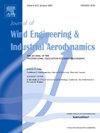高速列车通过时安装在轨道表面的平板和多孔筛上的风荷载
IF 4.2
2区 工程技术
Q1 ENGINEERING, CIVIL
Journal of Wind Engineering and Industrial Aerodynamics
Pub Date : 2024-11-26
DOI:10.1016/j.jweia.2024.105951
引用次数: 0
摘要
通过在有砟轨道的直线段枕木上方水平安装若干平板,对高速列车通过时的风压波动进行了实地测量。风压传感器被安装在这些平板的上下表面,以捕捉垂直方向的风压波动。这项研究的主要目的是调查高速列车通过时平板上风压波动的性质,估算作用在轨道表面平板和多孔筛网上的风荷载,并评估它们被风荷载抬起的敏感性。结果表明,压差是造成平板上风荷载的主要因素,而压差是由列车中段下方的湍流驱动的。此外,风压数据还被用来估算由于紊流而作用在平板和多孔屏蔽上的风荷载(提升力),并计算出防止提升所需的固定荷载。本文章由计算机程序翻译,如有差异,请以英文原文为准。
Wind loads on flat plates and porous screens installed on the track surface during the passage of high-speed trains
Field measurements of wind pressure fluctuations during high-speed train passages were conducted by horizontally installing several flat plates above sleepers on a straight section of ballasted track. Wind pressure sensors were attached to the top and bottom surfaces of these plates to capture vertical wind pressure fluctuations. The primary objectives of this study are to investigate the nature of fluctuating wind pressure on flat plates during high-speed train passages, to estimate the wind loads acting on flat plates and porous screens on the track surface, and to evaluate their susceptibility to being lifted by wind loads. The results reveal that the differential pressure, which is the primary contributor to wind loads on the flat plates, is driven by the turbulent flow beneath the middle section of the train. Additionally, wind pressure data were used to estimate the wind loads (lift forces) acting on the flat plates and porous screens due to the turbulent flow, and to calculate the fixation loads required to prevent lifting.
求助全文
通过发布文献求助,成功后即可免费获取论文全文。
去求助
来源期刊
CiteScore
8.90
自引率
22.90%
发文量
306
审稿时长
4.4 months
期刊介绍:
The objective of the journal is to provide a means for the publication and interchange of information, on an international basis, on all those aspects of wind engineering that are included in the activities of the International Association for Wind Engineering http://www.iawe.org/. These are: social and economic impact of wind effects; wind characteristics and structure, local wind environments, wind loads and structural response, diffusion, pollutant dispersion and matter transport, wind effects on building heat loss and ventilation, wind effects on transport systems, aerodynamic aspects of wind energy generation, and codification of wind effects.
Papers on these subjects describing full-scale measurements, wind-tunnel simulation studies, computational or theoretical methods are published, as well as papers dealing with the development of techniques and apparatus for wind engineering experiments.

 求助内容:
求助内容: 应助结果提醒方式:
应助结果提醒方式:


